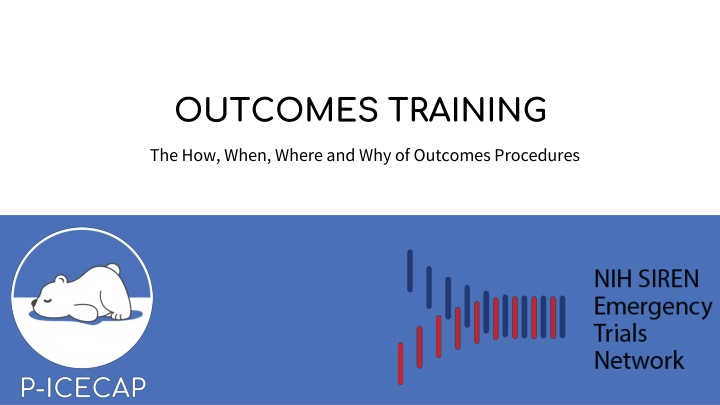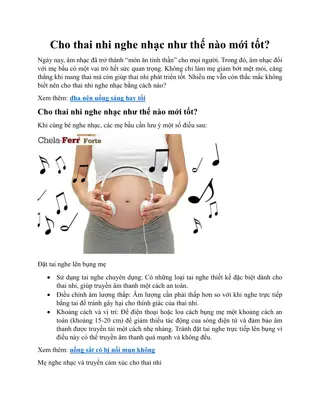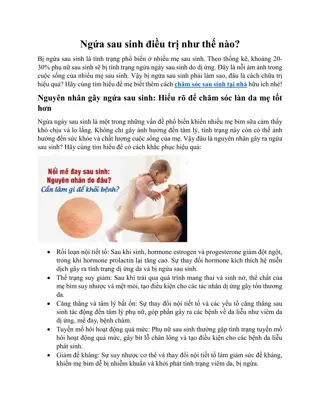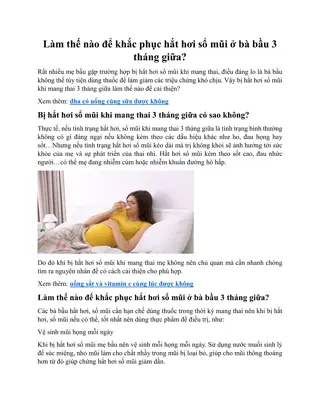Outcomes Procedures: The How, When, Where, and Why
This content delves into the intricacies of outcomes procedures with a focus on training opportunities provided by NHLBI and NINDS. Exploring the essentials of outcome-related practices, the text sheds light on the significance of understanding the processes involved in achieving desired outcomes.
Download Presentation

Please find below an Image/Link to download the presentation.
The content on the website is provided AS IS for your information and personal use only. It may not be sold, licensed, or shared on other websites without obtaining consent from the author.If you encounter any issues during the download, it is possible that the publisher has removed the file from their server.
You are allowed to download the files provided on this website for personal or commercial use, subject to the condition that they are used lawfully. All files are the property of their respective owners.
The content on the website is provided AS IS for your information and personal use only. It may not be sold, licensed, or shared on other websites without obtaining consent from the author.
E N D
Presentation Transcript
OUTCOMES TRAINING The How, When, Where and Why of Outcomes Procedures NHLBI UG3HL159134, U24HL159132 NINDS U24NS100659, U24NS100655
What does P-ICECAP Outcomes mean? Information at Baseline 3-Month VABS-3 12-Month VABS-3 12-Month Neurologic exam NHLBI UG3HL159134, U24HL159132 NINDS U24NS100659, U24NS100655
Information at Baseline POPC and PCPC Pediatric Overall Performance Category and Pediatric Cerebral Performance Category Family and Household Information Peds QL Pediatric Quality of Life Survey Baseline Contact Form Within 48 hours 1. 2. 3. 4. NHLBI UG3HL159134, U24HL159132 NINDS U24NS100659, U24NS100655
NHLBI UG3HL159134, U24HL159132 NINDS U24NS100659, U24NS100655
POPC and PCPC (baseline and 30 day/DC) Decision Tree for Determining Level of Impairment on Both the PCPC and POPC: Normal/Good = If the child has no disability or medical conditions, and is functioning appropriately, the child should be classified as Normal on the PCPC and Good on the POPC. Mild Disability = If the child has minor delays or functional impairments and most skills are within age-appropriate limits, or the child has well-controlled medical conditions, the child should be classified as Mild Disability . Moderate Disability = If the child is significantly delayed or functionally impaired in most areas and demonstrates some level of independence in activities of daily living, the child should be classified as Moderate Disability . Severe Disability = If the child is responsive to the environment but dependent on others for daily support because of impaired brain functioning or other medical conditions (excluding age), the child is classified as Severe Disability . Coma/Vegetative State = If the child has any degree of coma, is unaware and unresponsive, even if awake in appearance, without interaction with environment, the child is classified as Coma/Vegetative State . NHLBI UG3HL159134, U24HL159132 NINDS U24NS100659, U24NS100655
How to gather information for Baseline POPC & PCPC Review the medical record for the pre-CA level of impairment, medical conditions, AND etiology of the delays of functional impairments. (baseline: well-child visits) If you cannot find information in the record, please ask the caregiver about any medical diagnoses or conditions the child had prior to the cardiac arrest. For all identified diagnoses or conditions, please ask whether the diagnosis/condition limited the child s functioning (prior to the cardiac arrest) in any way. NHLBI UG3HL159134, U24HL159132 NINDS U24NS100659, U24NS100655
Family and Household Information This is a simple one-page form that you can hand the caregiver to complete. The family may be so distressed that you may need to do this interview-style. We don t recommend leaving it with the family to complete at their convenience you ll probably never see it again. Toolbox | SIREN NHLBI UG3HL159134, U24HL159132 NINDS U24NS100659, U24NS100655
Pediatric Quality of Life Inventory (Peds QL) You must pick the correct form for the age of the child. These forms are in the P-ICECAP Website Toolbox Toolbox | SIREN NHLBI UG3HL159134, U24HL159132 NINDS U24NS100659, U24NS100655
Baseline Contact Form Collect as much information about contacting the family on this form as you can. This is a living document for you to keep at your site and share with Kennedy Krieger Institute (KKI) via Dropbox when appropriate. This form does not get entered into webDCU PHI! This is why we are using a secure Dropbox. (instructions forthcoming) The Contact Form is in the toolbox as well. Toolbox | SIREN There is also a Contact Tracking Log for you to use to track how and when you have reached out to families. Useful to have if the CCC has questions for those families that seem hard to reach. NHLBI UG3HL159134, U24HL159132 NINDS U24NS100659, U24NS100655
!!!!!At 2 months and 11 months!!!!! At 2 months and at 11 months you will reach out to family, update the form if needed, and then load the form/updated form to the secure dropbox. For both timepoints you can already schedule the interview if the family is willing. Add this information to your contact form. They should expect a call from a 443-923-XXXX number For the 11-month time point, include on the contact form when the neurologic exam is. ***** The 12-month VABS MUST be completed before the neurologic exam***** KKI (Beth Slomine and Nisha Amin) will retrieve the Contact form from the Dropbox at those timepoints and use the information to contact the family for the 3-month and 12-month VABS-3 surveys. They may reach out to you if there are questions. Please respond quickly if they do! NHLBI UG3HL159134, U24HL159132 NINDS U24NS100659, U24NS100655
The 12-month Neurologic exam The Neurologic Exam Form in webDCU is called the PRCA (Pediatric Resuscitation after Cardiac Arrest) Score. The RC should reach out to the site s neurologist early to set up the 12-month exam because clinics can fill up way in advance. Get your participant appointment set up early! REMEMBER the 12-month VABS-3 must be completed BEFORE the neurologic exam. WINDOWS: if you look on the Schedule of Assessments, there are windows for the VABS-3 and neurologic exam (+/- 15 days) so plan your VABS-3 date early in the window and the neurologic exam after that. NHLBI UG3HL159134, U24HL159132 NINDS U24NS100659, U24NS100655
The 12-month Neurologic Exam cont There will be a brief orientation in fall for all neurologists doing the 12-month exam If your site has not yet identified a neurologist, please do so and send the contact information to Dr. Frank Moler (fmoler@med.umich.edu) and Dr. Faye Silverstein (fsilvers@med.umich.edu) On the day of the 12-month neurologic exam, print out the PRCA from webDCU and hand it to the neurologist. As soon as you get it back LOOK IT OVER CAREFULLY! If anything is blank, follow up right away. You will be entering this form into webDCU. NHLBI UG3HL159134, U24HL159132 NINDS U24NS100659, U24NS100655
(A note about P-ICECAP and days) Day 1 visit is from initiation of temperature control device through the end of the calendar day (23:59). (this will be before randomization!) Day 2 visit is the next day 00:00 through 23:59. NHLBI UG3HL159134, U24HL159132 NINDS U24NS100659, U24NS100655























